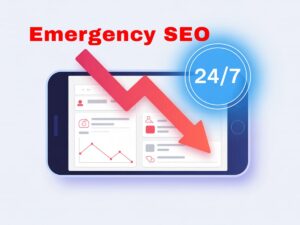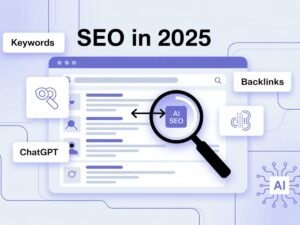The rise of AI answer engines marks one of the biggest shifts in digital marketing since the invention of Google Search itself. Traditional SEO was built around optimizing web pages for keyword rankings on search results pages. But now, with the introduction of AI-driven answer engines—like Google’s AI Overviews, Microsoft’s Copilot, Perplexity, and ChatGPT Search—the focus has changed. Instead of competing for blue links, businesses must compete for visibility and citations inside AI answers. This shift demands a new discipline: Answer Engine Optimization (AEO).
But how do you actually track your performance in AI answer engines? How can you measure whether your content is appearing, cited, or even driving traffic when most AI answers don’t show analytics? This guide breaks down a complete framework to help marketers, business owners, and SEO professionals monitor performance, improve visibility, and adapt to the new AI-powered search landscape.
Understanding AI Answer Engines
Before we can track anything, it’s important to understand what an AI answer engine really is. Unlike traditional search engines, which list links to web pages, AI answer engines use large language models (LLMs) to generate direct answers. They synthesize information from multiple sources—sometimes citing them, sometimes not—and present users with a complete response.
Examples include:
- Google AI Overviews (part of Google’s AI Mode and Search Generative Experience)
- Bing Copilot (integrated into Edge and Microsoft 365)
- Perplexity AI, which cites and links to its sources
- ChatGPT Search (powered by GPT-4 and live web data)
For businesses in Vancouver, Texas, and Utah, this evolution means your local SEO efforts are no longer just about ranking your website—they’re about getting your content recognized and referenced by AI engines. If your content is seen as trustworthy, relevant, and authoritative, it can be surfaced inside AI-generated summaries that millions of users see every day.
Why Tracking AI Answer Engine Performance Matters
When you can’t measure performance, you can’t improve it. In traditional SEO, we have precise data: impressions, clicks, positions, and CTRs. In the AI era, these metrics are less visible. Many AI platforms don’t yet provide analytics or referral data. However, tracking AI visibility is still possible through observation, manual testing, and emerging third-party tools.
Understanding your AI performance helps you:
- Discover whether your content is being cited in AI answers.
- Evaluate how AI models interpret your expertise and topical authority.
- Identify keyword gaps and content weaknesses.
- Adapt your content strategy to align with AI learning patterns.
- Measure the downstream impact on traffic and conversions.
In short, AI tracking = future SEO tracking. Businesses that learn to monitor AI visibility today will dominate tomorrow’s search environment.
Key Metrics to Track in AI Answer Engines
Because AI answer engines behave differently than search engines, the performance metrics you monitor also change. Here are the most important ones to track:
1. AI Citation Frequency
This is the number of times your website or brand is cited as a source in AI-generated answers. For example, if Perplexity or Bing Copilot lists your URL, that counts as one citation. The more often your content is used, the stronger your authority signal.
2. AI Overview Impressions
In Google AI Mode, certain pages may appear as references under the “Sources” section. Tracking how often your content appears there helps you measure brand exposure.
3. Click-Through and Engagement
Some AI platforms include direct links in their answers. You can track traffic spikes or referral data in analytics platforms (Google Analytics, Plausible, or Matomo) when users click through from AI-generated results.
4. Mentions and Brand References
AI answer engines sometimes summarize your brand name or expertise even without linking to your site. Use social listening or AI monitoring tools to detect these mentions.
5. Conversion and Traffic Lift
Ultimately, the goal is conversion. Even if users don’t click from AI answers, brand recognition can increase conversions later through branded searches.
Tracking all these metrics requires creativity, manual review, and new tools—but it’s essential for staying ahead of your competition.
Tools and Techniques for Monitoring AI Performance
While there’s no single dashboard (yet) for AI answer engine analytics, you can combine several methods to track your performance effectively.
1. Manual SERP Observation
Search your target keywords regularly in Google’s AI Mode and note whether your content appears in the AI Overview section. Do the same in Bing Copilot and Perplexity.
2. AI Tracking Tools
New tools like AlsoAsked, Neural.love AI SEO Tracker, Ziptie, or Perplexity Monitoring Tools can help you detect citations and inclusion frequency. Some platforms are starting to integrate AEO metrics into their SEO suites.
3. Branded Query Testing
Type queries such as “site:maznurrahman.com AI Overviews” or “Maznur Rahman SEO expert in AI summaries” to see where your brand appears.
4. Web Analytics
While AI referrals are often hidden, any unusual traffic increases from direct or unlisted sources could be the result of AI answer exposure.
5. ChatGPT and Gemini Prompt Tests
Use prompts like “Who are the top SEO experts in Texas?” or “How do I track performance in AI answer engines?” If your brand is mentioned, you’ve earned AI authority.
For Maznur Rahman’s clients in Vancouver, Texas, and Utah, combining these methods provides a near-real-time sense of where your content is surfacing in AI environments and how it’s performing.
Best Practices to Improve AI Answer Engine Performance
Once you can track your performance, the next step is improving it. AI answer engines prefer clear, structured, factual content that directly addresses search intent. Here’s how to strengthen your AEO visibility:
- Use Conversational, Question-Based Headings
Frame sections around real user questions: “How can I track AI citations?” or “What metrics matter for AI answer visibility?” - Add Structured Data and Schema
Implement FAQ and Q&A schema markup so AI can easily extract and cite your answers. - Strengthen E-E-A-T (Experience, Expertise, Authority, Trust)
Include author bios, credentials, original research, and client case studies to show credibility. - Publish Clear and Factual Information
AI models prefer reliable data and clearly worded statements. Avoid jargon or fluff—clarity wins citations. - Monitor Content Freshness
Update your blog posts frequently. AI models favor newer sources when generating summaries. - Leverage Multiple Formats
Create short explainer videos on YouTube, publish Medium articles, and share thought leadership posts on LinkedIn. Cross-platform authority improves your AI visibility.
By following these best practices, your brand becomes more “AI-ready,” ensuring that LLMs and answer engines recognize and trust your content.
Challenges in Tracking AI Answer Engine Metrics
While tracking AI performance is critical, it’s not without challenges. The biggest issue is opacity—AI answer engines don’t always reveal where their information comes from. Some cite sources, others don’t. Google AI Overviews often provide citations but not impression counts.
Other challenges include:
- Lack of standardized analytics tools for AEO.
- Zero-click results, where users get answers directly without visiting your website.
- Attribution confusion, where AI blends multiple sources into one answer.
- Constant algorithm evolution, as AI systems learn and update daily.
Despite these challenges, the solution is persistence and data collection. Track manually, use available AI monitoring tools, and keep refining your strategy.
Case Study Example: Applying AI Tracking for SEO Growth
Imagine a digital marketing agency in Vancouver tracking its visibility in Google’s AI Mode. Initially, its content rarely appeared in AI Overviews. After optimizing articles with clear H2 question formats, adding schema, and strengthening E-E-A-T, citations began appearing more frequently.
Similarly, a Texas-based e-commerce brand started monitoring its AI exposure using Perplexity. Within months, its product guides began being cited as sources, leading to higher branded search traffic.
Meanwhile, a Utah local business improved its AEO performance by integrating structured FAQs into blog content. The business later noticed its website being referenced by AI tools, which increased inquiries and local awareness.
These examples prove that tracking and improving AI answer engine visibility isn’t theoretical—it drives real results when done strategically.
The Future of Performance Tracking in AI Search
As AI search continues to evolve, expect new analytics dashboards to emerge from platforms like Google Search Console, Bing Webmaster Tools, and third-party SEO tools. Eventually, marketers will be able to see AI Overview impressions, citation counts, and engagement data.
In the meantime, tracking performance in AI answer engines requires a proactive, hybrid approach—combining SEO expertise, analytics insights, and creative observation. By learning these skills now, your brand will be ready when AI visibility becomes the primary digital currency.
For businesses and marketers in Vancouver, Texas, and Utah, embracing AI answer engine optimization early offers a major competitive advantage.
FAQs
You can check by running your keywords in Google’s AI Mode, Perplexity, or Bing Copilot. If your domain appears under “Sources,” it means your content has been cited.
Use a mix of manual observation, AI citation trackers, and analytics tools like Ahrefs or SEMrush with AEO insights.
Not yet—but it’s becoming just as important. AI citations build trust and brand awareness even without direct clicks.
Schema helps AI understand and extract answers more easily, improving your citation potential.
Maznur Rahman provides full AEO and AI visibility audits, optimizing your content to perform in Google AI Mode and other answer engines—ensuring your brand stays ahead of the AI revolution.














